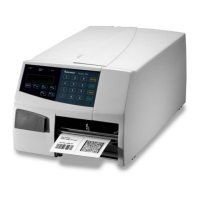164 Intermec EasyCoder PF2i, PF4i, and PF4i Compact Industrial—Service Manual
Chapter 14—Interfaces
14.1 Introduction
In Fingerprint, "auto" is by default the standard IN and OUT
communication port, that is, the printer will scan all communication
channels for incoming data. To select a specifi c communication port as
standard IN and/or standard OUT port, use an Intermec Fingerprint
SETSTDIO statement (see Intermec Fingerprint v8.xx, Programmer’s
Reference Manual). This gives better performance. Note that many
application programs, for example Intermec Shell, contain instructions
that select the correct standard I/O for the application in question. The
settings for the selected communication channel will appear in the display
window when pressing the <info> key on the printer’s keyboard.
In IPL, all communication channels are always scanned for incoming data
and the fi rmware automatically switches to the same channel for output
too. The settings for the active communication channel will appear in the
display window when pressing the <info> key on the printer’s keyboard.
The standard interfaces (RS-232, USB, and Wand) are fi tted directly on
the rear of the CPU board with connectors protruding through slots in the
printer’s rear plate. USB and Wand are not supported by IPL.
All optional interface boards, except the EasyLAN boards, are fi tted in a
slot on the printer’s standard rear plate and connected to the CPU board
via a fl at cable. If no interface board is fi tted, the slot is closed by a cover
plate.
The EasyLAN boards are fi tted directly to the front of the CPU board and
connected by wire to a connector or antenna. There is a provision for the
wired EasyLAN connector on the standard rear plate, but a special rear
plate is required for EasyLAN Wireless antenna. All rear plates have a slot
for an interface board as well as for the standard interface connectors.

